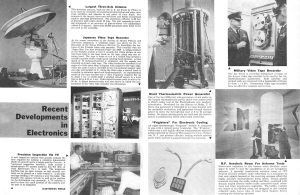Recent Developments in Electronics
|
|
For many years, Electronics World magazine ran a "Recent Developments in Electronics" feature that highlighted guess what? Yep, recent development in electronics. This July 1965 issue reported on, amongst other things, the largest (at the time - 60 feet) three-axis radio frequency antenna, manufactured by Philco, for use in satellite tracking. Not even a full two years had passed since the launch of America's first transponder-equipped satellite, SCORE. Also shown was a "Frigistor" for electronic cooling, exploiting the thermoelectric effect. The only patent I could find is registered in Great Britain (GB1033018A). The trademark (expired) says, "Thermoelectric Cooling Assemblies Consisting of One or More Couples of P and N Type." Another key item was a huge (for the time - a whopping 60 feet) RF anechoic chamber by ITT Federal Division for use in testing satellites in an "outer space" environemnt. Recent Developments in Electronics This precision antenna, built for the U. S. Air Force by Philco, is to be used for reception of telemetered information and other data from satellites and missiles in any phase of their flight. The antenna is the largest three-axis structure and boasts exceptional rigidity and high performance. The aluminum reflector is 60 feet in diameter and weighs about 15 tons. The unit responds to tracking commands to an accuracy of plus-or-minus two milliradians (about 0.11 degree). More than 30,000 aluminum alloy blind rivets are used in the assembly. "Frigistors" for Electronic Cooling An eight-thermocouple "Frigistor" module is compared in size with a typical power transistor. The "Frigistor," which uses a new highly efficient semiconductor material being marketed by General Thermoelectric Corp., Princeton, N. J., can produce effective cooling without moving parts when current is passed through the material. R.F. Anechoic Room for Antenna Tests Electronics engineers in this bizarre room simulate outer space in order to test the capabilities of an air navigation antenna. A specially constructed anechoic room at ITT Federal Division reduces radio reflections to a minimum so that only signals beamed at the receiving antenna affect the highly accurate measurements being taken. Porous plastic material covering the walls, ceiling, and floor, combined with sharply angled interior baffles make unwanted signal reflections and other interference negligible. The baffles, running the length of the 60-foot room, are designed so that random reflected radio waves take at least three bounces before reaching the detecting antenna.
Posted December 28, 2022 |
|

